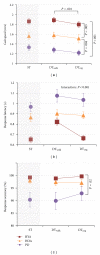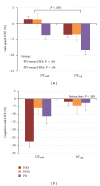The effects of instructions on dual-task walking and cognitive task performance in people with Parkinson's disease
- PMID: 23326758
- PMCID: PMC3544310
- DOI: 10.1155/2012/671261
The effects of instructions on dual-task walking and cognitive task performance in people with Parkinson's disease
Abstract
Gait impairments are prevalent among people with Parkinson's disease (PD). Instructions to focus on walking can improve walking in PD, but the use of such a cognitive strategy may be limited under dual-task walking conditions, when walking is performed simultaneously with concurrent cognitive or motor tasks. This study examined how dual-task performance of walking and a concurrent cognitive task was affected by instructions in people with PD compared to healthy young and older individuals. Dual-task walking and cognitive task performance was characterized under two sets of instructions as follows: (1) focus on walking and (2) focus on the cognitive task. People with PD and healthy adults walked faster when instructed to focus on walking. However, when focused on walking, people with PD and young adults demonstrated declines in the cognitive task. This suggests that dual-task performance is flexible and can be modified by instructions in people with PD, but walking improvements may come at a cost to cognitive task performance. The ability to modify dual-task performance in response to instructions or other task and environmental factors is critical to mobility in daily life. Future research should continue to examine factors that influence dual-task performance among people with PD.
Figures


Similar articles
-
The ability of people with Parkinson's disease to modify dual-task performance in response to instructions during simple and complex walking tasks.Exp Brain Res. 2014 Jan;232(1):263-71. doi: 10.1007/s00221-013-3737-4. Epub 2013 Oct 27. Exp Brain Res. 2014. PMID: 24162861 Free PMC article.
-
Effects of instructed focus and task difficulty on concurrent walking and cognitive task performance in healthy young adults.Exp Brain Res. 2010 Nov;207(1-2):65-73. doi: 10.1007/s00221-010-2429-6. Epub 2010 Oct 8. Exp Brain Res. 2010. PMID: 20931180 Free PMC article.
-
A review of dual-task walking deficits in people with Parkinson's disease: motor and cognitive contributions, mechanisms, and clinical implications.Parkinsons Dis. 2012;2012:918719. doi: 10.1155/2012/918719. Epub 2011 Oct 27. Parkinsons Dis. 2012. PMID: 22135764 Free PMC article.
-
A meta-analysis: Parkinson's disease and dual-task walking.Parkinsonism Relat Disord. 2019 May;62:28-35. doi: 10.1016/j.parkreldis.2018.12.012. Epub 2018 Dec 12. Parkinsonism Relat Disord. 2019. PMID: 30594454 Free PMC article. Review.
-
Loss of gait control assessed by cognitive-motor dual-tasks: pros and cons in detecting people at risk of developing Alzheimer's and Parkinson's diseases.Geroscience. 2017 Jun;39(3):305-329. doi: 10.1007/s11357-017-9977-7. Epub 2017 May 27. Geroscience. 2017. PMID: 28551877 Free PMC article. Review.
Cited by
-
The JFK BIG study: the impact of LSVT BIG® on dual task walking and mobility in persons with Parkinson's disease.J Phys Ther Sci. 2018 Apr;30(4):636-641. doi: 10.1589/jpts.30.636. Epub 2018 Apr 20. J Phys Ther Sci. 2018. PMID: 29706722 Free PMC article.
-
Dual-Task Effects During a Motor-Cognitive Task in Parkinson's Disease: Patterns of Prioritization and the Influence of Cognitive Status.Neurorehabil Neural Repair. 2021 Apr;35(4):356-366. doi: 10.1177/1545968321999053. Epub 2021 Mar 10. Neurorehabil Neural Repair. 2021. PMID: 33719728 Free PMC article. Clinical Trial.
-
Cognitive Contributions to Freezing of Gait in Parkinson Disease: Implications for Physical Rehabilitation.Phys Ther. 2016 May;96(5):659-70. doi: 10.2522/ptj.20140603. Epub 2015 Sep 17. Phys Ther. 2016. PMID: 26381808 Free PMC article.
-
Balance impairment in patients with moderate-to-severe traumatic brain injury: Which measures are appropriate for assessment?Front Neurol. 2022 Aug 3;13:906697. doi: 10.3389/fneur.2022.906697. eCollection 2022. Front Neurol. 2022. PMID: 35989909 Free PMC article.
-
Do cognitive and physical fatigue tasks enhance pain, cognitive fatigue, and physical fatigue in people with fibromyalgia?Arthritis Care Res (Hoboken). 2015 Feb;67(2):288-96. doi: 10.1002/acr.22417. Arthritis Care Res (Hoboken). 2015. PMID: 25074583 Free PMC article.
References
-
- Wielinski CL, Erickson-Davis C, Wichmann R, Walde-Douglas M, Parashos SA. Falls and injuries resulting from falls among patients with Parkinson’s disease and other Parkinsonian syndromes. Movement Disorders. 2005;20(4):410–415. - PubMed
-
- Muslimović D, Post B, Speelman JD, Schmand B, De Haan RJ. Determinants of disability and quality of life in mild to moderate Parkinson disease. Neurology. 2008;70(23):2241–2247. - PubMed
-
- Post B, Merkus MP, De Haan RJ, Speelman JD. Prognostic factors for the progression of Parkinson’s disease: a systematic review. Movement Disorders. 2007;22(13):1839–1851. - PubMed
-
- Gray P, Hildebrand K. Fall risk factors in Parkinson’s disease. The Journal of Neuroscience Nursing. 2000;32(4):222–228. - PubMed
-
- O’Shea S, Morris ME, Iansek R. Dual task interference during gait in people with Parkinson disease: effects of motor versus cognitive secondary tasks. Physical Therapy. 2002;82(9):888–897. - PubMed
Grants and funding
LinkOut - more resources
Full Text Sources
Medical

